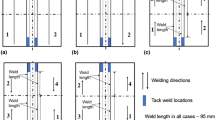Abstract
Finite element method (FEM) is a powerful tool for analysing the potential deformation during a material removal process. After the removal of material, re-establishment of equilibrium within the remaining part of the structure causes distortion due to the relief of residual stress in the removed materials. In this study, commercial FEM software (MSC.Marc) was used to simulate material removal, and the accuracy was evaluated by comparison with results from machining experiments. The effect of cutting height on the distortion redistribution and the kerf width in a T-joint welded structure is discussed, and the distortion differences at the centre line of the bottom were compared between the calculated and experimental results. The results demonstrate that the developed model is useful and efficient for simulating the redistribution of welding distortion due to material removal.
Similar content being viewed by others
References
R. Wang, J. X. Zhang, C. Liu, H. Serizawa and H. Murakawa, Welding distortion investigation in fillet welded joint structure based on iterative substructure method, Science and Technology of Welding & Joining, 14 (5) (2009) 396–403.
H. Murakawa, Y. Luo and Y. Ueda, Prediction of welding deformation and residual stress by elastic FEM based on inherent strain (first report)–mechanism of inherent strain production, Journal of the Society of Naval Architects of Japan, 180 (1996) 739–751.
A. V. Saenz, Development of inherent deformation database for automatic forming of thick steel plates by line heating considering complex heating patterns, Doctoral Thesis, Osaka University, Japan.
B. Zuheir, M. Ghanadi and S. Balawi, Managing welding induced distortion–Comparison of different computational approaches, Procedia Engineering, 114 (2015) 70–77.
T. J. Ko and H. S. Kim, Mechanistic cutting force model in band sawing, International Journal of Machine Tools & Manufacture, 39 (8) (1999) 1185–1197.
M. E. Merchant, Mechanics of the metal cutting process, J. Appl. Phys., 16 (5) (1945) 267–275.
E. Ceretti, P. Fallbohmer, W. T. Wu and T. Altan, Application of 2D FEM to chip formation in orthogonal cutting, Journal of Materials Processing Technology, 59 (1) (1996) 169–180.
Z. Wang, W. Chen, Y. Zhang, Z. Chen and Q. Liu, Study on the machining distortion of thin-walled part caused by redistribution of residual stress, Chinese Journal of Aeronautics, 18 (2) (2005) 175–179.
Marc 2011 User’s Guide, FEM simulation of NC machining and PRE STATE, Part 1 393-430.
C. Wang, Y.-R. Kim and J.-W. Kim, Comparison of FE models to predict the welding distortion in T-joint gas metal arc welding process, IJPEM, 15 (8) (2014) 1631–1637.
Y.-R. Kim, C. Wang and J.-W. Kim, Experimental study of the redistribution of welding distortion according to the partial removal of welded structure, Trans. of KSME, 25 (10) (2015) 2641–2646.
T. Sasayama, K. Masubuchi and S. Moriguchi, Longitudinal deformation of a long beam due to fillet welding, Welding Journal, 34 (12) (1995) 581.
Author information
Authors and Affiliations
Corresponding author
Additional information
Recommended by Associate Editor Young Whan Park
Chao Wang was born in JiangYin, China. He is currently studying for Ph.D. degree at the Graduate School of Yeungnam University, Korea. His areas of research interest include finite element analyses of welding and heat treatment of steel structures.
Yong-Rae Kim received his B.Sc. degree from Yeungnam University, Korea, in 2009. He then received his M.Sc. degree from Yeungnam University, Korea, in 2012. He is currently a Ph.D. candidate at Yeungnam University, Korea. His research interests include analysis of welded structures, thermal stress and distortion.
Jae-Woong Kim received his B.Sc. degree from Ajou University, Korea, in 1982. He received his M.Sc. and Ph.D. degrees in Mech. and Production Eng. from Korea Advanced Institute of Science and Technology, in 1984 and 1991, respectively. He is currently a professor at the School of Mech. Eng., Yeungnam University, Korea. His research interests include analysis of welded structures, thermal stress and distortion.
Rights and permissions
About this article
Cite this article
Wang, C., Kim, YR. & Kim, JW. Numerical modelling of welding distortion redistribution due to the change of self-constraint in a T-joint welded structure. J Mech Sci Technol 30, 2683–2690 (2016). https://doi.org/10.1007/s12206-016-0529-3
Received:
Revised:
Accepted:
Published:
Issue Date:
DOI: https://doi.org/10.1007/s12206-016-0529-3




